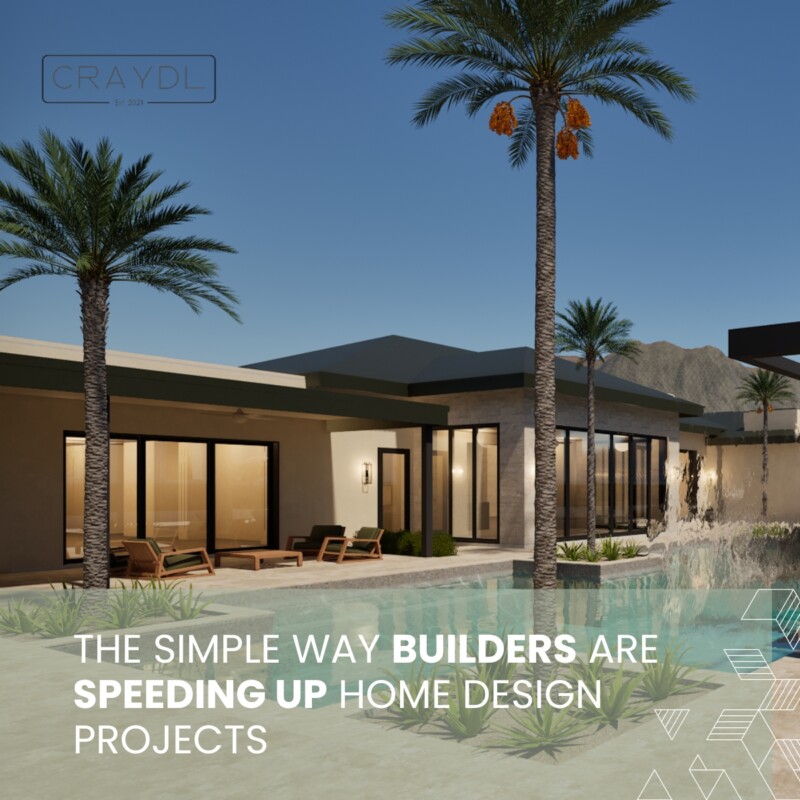We get this question all the time at CRAYDL: “Does using new design technology slow things down?” It’s a fair concern. After all, the last thing any builder or homeowner wants is another tool that complicates the process.
So let’s break it down.
The short answer? No. In fact, the right tools do the opposite. They speed things up, keep everyone aligned, and help projects finish on time and on budget. When it comes to builders speeding up home design, the right technology can make all the difference.
When Everyone’s Aligned On Your Project, Everything Moves Faster
Delays happen when information lives in too many places. One version of the plan ends up in someone’s inbox, another in a markup, and another in someone’s head. By the time everyone compares notes, the team’s already chasing the latest update.
Now imagine one shared model that brings it all together, including your design choices, quantities, schedules, and updates, all connected and visible to everyone involved. Suddenly, communication becomes clear. Decisions happen faster. Builders stay in control. Designers can focus on creativity instead of revisions. Homeowners gain confidence because they can see their project take shape before construction starts.
That kind of clarity eliminates the guesswork that normally slows everything down.
Catching Issues Early Saves You Money
Every project has hidden details that can derail a timeline, often small things that turn into big problems once construction starts. That’s exactly where virtual design, systems coordination, and BIM Management make the difference.
In one project, the team used CRAYDL’s design tools during the preconstruction planning phase to uncover issues long before anyone stepped on site. The model identified missing mechanical closets, resolved a beam lock, and caught missing hardscape specifications that would have caused major rework down the line. During construction, the same shared model made it easy to facilitate real-time design updates, keeping the entire team aligned through every change.
The result? An ROI of more than 400% and an extremely happy customer!
When everything is modeled accurately from the start, surprises disappear. Projects stay on track, budgets stay intact, and builders gain confidence knowing every detail has been accounted for before construction begins.
Building Delays Cost More Than You Think
Every extra week on a job site adds pressure to the builder, stress to the homeowner, and cost to the project. Studies show that extended timelines can increase total expenses by up to 35%. That’s a big hit for something that often comes down to miscommunication or missing information.
When everyone’s connected and informed, that risk drops dramatically. Projects move smoothly, teams stay proactive, and clients see results sooner.
The Future of Home Design Is Collaborative
Virtual design has completely changed how modern projects come together and reshaped how top builders, architects, and designers work. Instead of passing around files and hoping everything aligns, they use connected digital models, or digital twins, that simulate the build from start to finish.
These models help catch conflicts early, coordinate schedules automatically, and make updates visible to every team member in real time. It’s faster and smarter.
Bring All Your Plans Together with CRAYDL
That’s exactly what CRAYDL was built for. CRAYDL is a builder-first virtual design construction (VDC) platform that’s remodeling the preconstruction experience by bringing builders, designers, and homeowners into perfect alignment.
Everything happens in one place on a shared digital twin where design, construction, and decision-making come together seamlessly. Updates connect automatically to quantities and schedules. Changes are visible in real time. Teams stay coordinated from start to finish.
Builders finish faster. Homeowners save money. And everyone wins when construction plans come together. Because rework sucks.
Ready to experience it for yourself?
See how CRAYDL can bring speed, savings, and clarity to your next project. 👇


